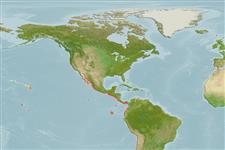Common names from other countries
>
Anguilliformes (Eels and morays) >
Ophichthidae (Snake eels) > Ophichthinae
Etymology: Apterichtus: From the Greek απτερόν (apteron), without fins, and ίχθύς (ichtus, more correctly written ichthys; masculine), fish..
More on authors: Myers & Wade.
Environment: milieu / climate zone / depth range / distribution range
Écologie
marin démersal; profondeur 10 - 134 m (Ref. 101270). Tropical; 29°N - 1°S
Eastern Pacific: between the Gulf of California and the Galapagos Islands.
Taille / Poids / Âge
Maturity: Lm ? range ? - ? cm
Max length : 31.2 cm TL mâle / non sexé; (Ref. 101270)
Description synthétique
Clés d'identification | Morphologie | Morphométrie
This species is distinguished by the following characters: tail 1.8-2.0, head 11-16, and body depth 43-50 in total length; preopercular pores 3 and pores in supratemporal canal 3; teeth conical and uniserial on jaws and vomer; vomerine teeth 4-5; body coloration when preserved is uniform light tan, overlain with fine sparse brown speckling, branchial region and top of head with irregular small dark spots and blotches; MVF 59138, 132-146 total vertebrae (Ref. 101270).
Inhabits sandy and muddy bottoms, from shallow waters (Ref. 9328); captured by rotenone, dredge and trawl (Ref. 101270).
Life cycle and mating behavior
Maturities | Reproduction | Spawnings | Egg(s) | Fecundities | Larves
McCosker, J.E. and Y. Hibino, 2015. A review of the finless snake eels of the genus Apterichtus (Anguilliformes: Ophichthidae), with the description of five new species. Zootaxa 3941(1):49-78. (Ref. 101270)
Statut dans la liste rouge de l'IUCN (Ref. 130435)
CITES (Ref. 128078)
Not Evaluated
Menace pour l'homme
Harmless
Utilisations par l'homme
Outils
Articles particuliers
Télécharger en XML
Sources Internet
Estimates based on models
Preferred temperature (Ref.
115969): 9.5 - 17.6, mean 12.9 (based on 39 cells).
Phylogenetic diversity index (Ref.
82804): PD
50 = 0.5000 [Uniqueness, from 0.5 = low to 2.0 = high].
Bayesian length-weight: a=0.00089 (0.00039 - 0.00204), b=3.00 (2.80 - 3.20), in cm Total Length, based on LWR estimates for this (Sub)family-body shape (Ref.
93245).
Niveau trophique (Ref.
69278): 3.8 ±0.6 se; based on size and trophs of closest relatives
Résilience (Ref.
120179): Haut, temps minimum de doublement de population inférieur à 15 mois (Preliminary K or Fecundity.).
Fishing Vulnerability (Ref.
59153): Low vulnerability (21 of 100).
